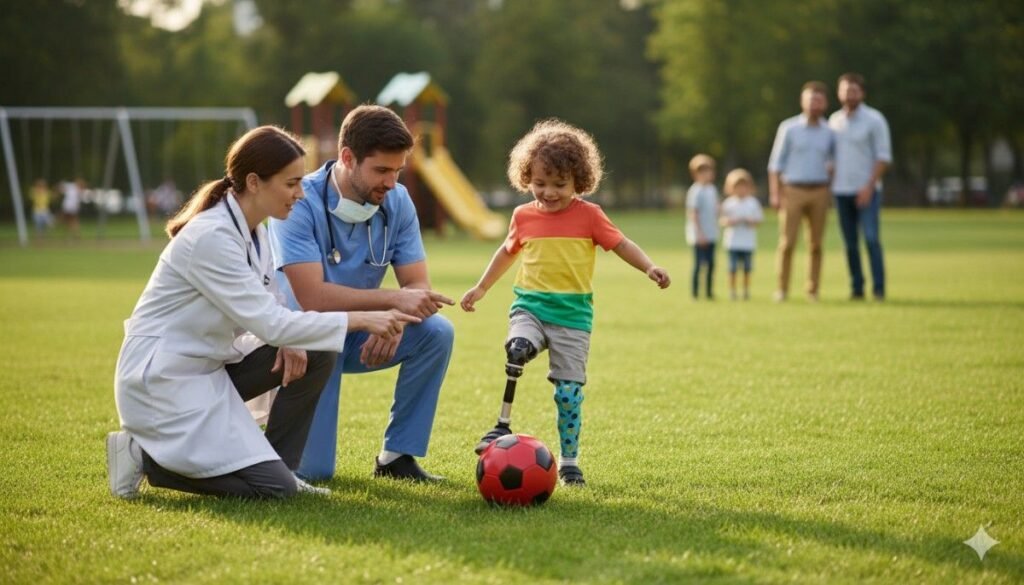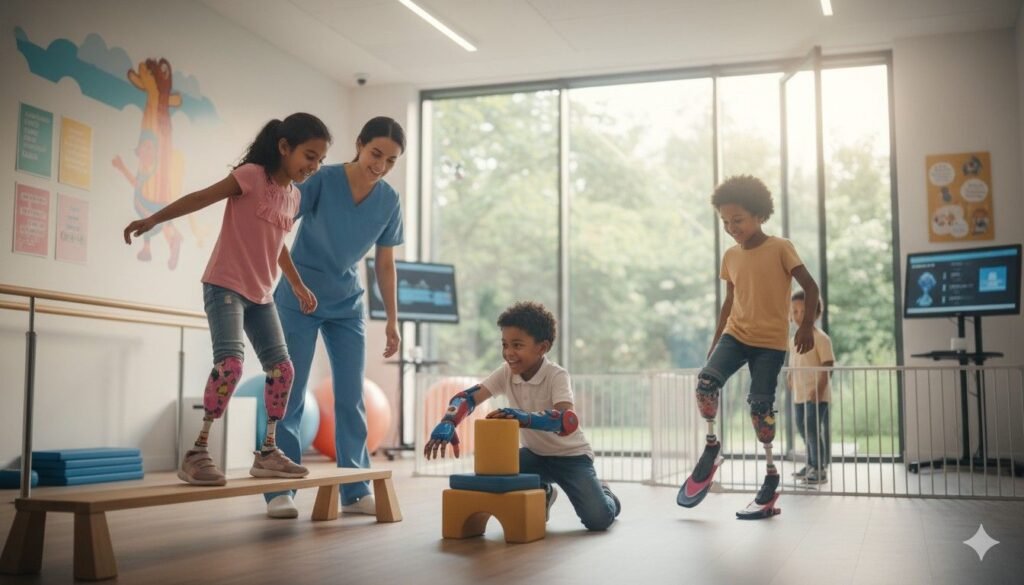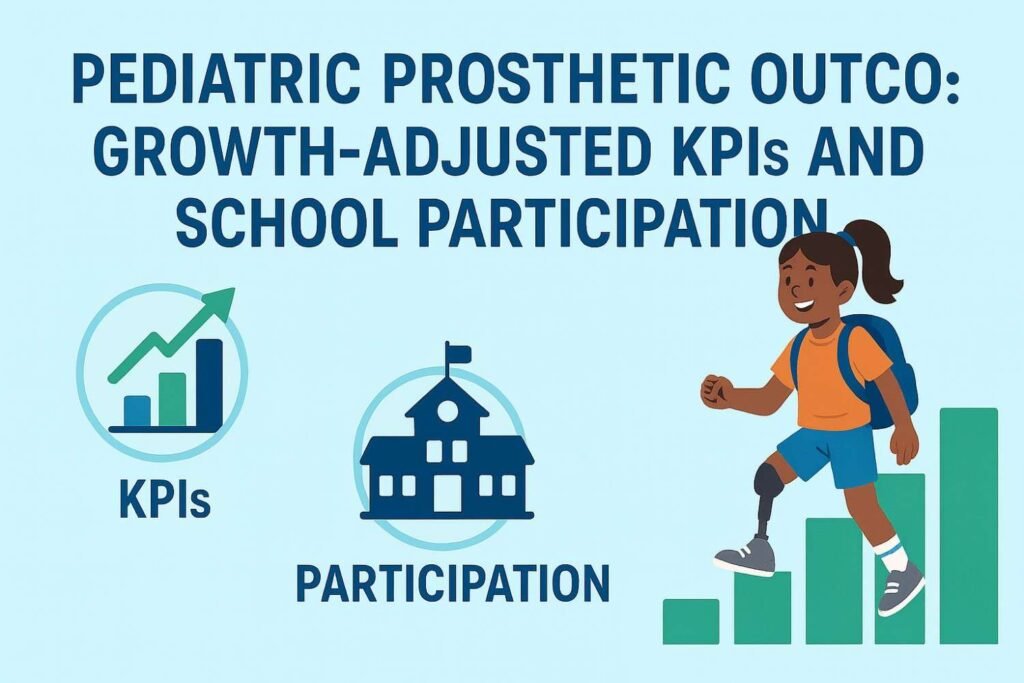Caring for a child with limb difference is very different from caring for an adult.
Children grow fast, learn fast, and adapt in ways that are both inspiring and unpredictable.
Because of this, their prosthetic outcomes must be measured with tools that respect growth, changing needs, and the daily realities of school, play, and social life.
Growth-adjusted KPIs help clinicians understand how well the prosthesis supports the child over time.
School participation shows how confidently the child moves, interacts, and keeps up with friends in real-world environments.
Together, these measures help doctors, therapists, and families build a clear path toward long-term independence.
Why Pediatric Outcomes Need a Different Approach
How Growth Changes Prosthetic Needs Constantly

Children do not stay the same size for long.
Their limbs grow, their muscles strengthen, and their activities expand every few months.
Because of this, a prosthesis that fits well today may feel loose, short, or uncomfortable in a short time.
Growth affects alignment, suspension, socket volume, and even the child’s confidence in movement.
This is why pediatric KPIs must be flexible, time-sensitive, and adjusted for rapid physical changes.
Why Emotional and Social Factors Matter More for Children
Children understand the world through play, curiosity, and friendships.
If their prosthesis holds them back socially, they may avoid using it, even if it fits well.
Emotional comfort plays a huge role in pediatric acceptance.
A child who feels embarrassed or different may hide their prosthesis or refuse to wear it.
This makes emotional support and school participation key parts of outcome tracking.
Why School Is the Best Testing Ground
School is where children spend most of their day—walking, writing, carrying bags, playing sports, handling art supplies, and interacting with classmates.
It is full of routine tasks and unpredictable movements.
School performance reflects real functional ability better than almost any clinical test.
Clinicians use school participation to understand whether the child is thriving with their prosthesis or struggling silently.
Understanding Growth-Adjusted KPIs
Why KPIs Must Adapt to the Child, Not the Other Way Around
Standard adult KPIs do not work well for children because they assume stable limb size and steady functional capacity.
Children change faster, learn faster, and outgrow their devices quickly.
Growth-adjusted KPIs reflect these natural changes by tracking outcomes relative to the child’s developmental stage.
This helps clinicians understand whether the child is actually improving or simply getting taller and adjusting their movement around discomfort.
How Growth Affects Socket Fit and Function
As the limb grows, the socket may become tight or painful.
This affects gait, balance, and activity levels.
If clinicians track only performance without adjusting for growth, they may misunderstand the reason behind a decline in function.
Growth-adjusted KPIs help separate growth-related issues from mechanical ones, allowing faster and more accurate care decisions.
How Growth Influence Skill Development
Children gain skills with every new school year—writing longer, carrying heavier bags, climbing bigger steps.
KPIs must reflect this natural progression.
What is normal for a 6-year-old may be too basic for an 8-year-old.
Growth-based KPIs ensure that expectations grow with the child, not remain stuck in earlier benchmarks.
Key Pediatric KPIs Clinicians Should Track
Participation Over Pure Performance
For children, participation is often more meaningful than technical performance.
A child who joins games, writes comfortably, and keeps up with classmates shows healthy adaptation.
Even if their gait is not perfect, participation reflects confidence, motivation, and comfort.
Clinicians prioritize participation because it predicts long-term prosthetic acceptance better than isolated clinical tests.
Comfort and Daily Wear Time
Children cannot always describe discomfort clearly.
They may simply remove the prosthesis, leave it at home, or avoid using it during play.
Daily wear time becomes a valuable indicator of comfort and emotional acceptance.
Wear-pattern changes often signal socket issues, peer pressure, or activity-based frustration.
Task Completion in School and Home
Clinicians track how well the child completes age-appropriate tasks—buttoning clothes, writing, cutting paper, climbing stairs, or holding sports equipment.
These tasks show whether the prosthesis supports everyday function.
Slower task performance or avoidance often means the child is compensating or struggling with control.
Why School Participation Is a Powerful KPI
School Shows the Child’s True Functional Needs
School environments challenge children in ways clinics cannot replicate.
They must carry bags, navigate crowded hallways, handle art tools, and participate in sports.
These tasks reveal whether the prosthesis supports natural, independent movement.
If a child struggles at school, clinicians know the device needs attention, even if clinic tests look fine.
Social Interaction Reflects Emotional Acceptance
School is where children form friendships and learn teamwork.
If they avoid group activities or hide their prosthesis, it signals emotional discomfort.
This type of avoidance is a critical indicator because it affects both functional progress and mental well-being.
Clinicians use school-based observations to guide counseling, peer integration, and confidence-building strategies.
Participation Predicts Long-Term Use
Children who feel confident and included at school tend to use their prosthesis more consistently over the years.
Children who feel embarrassed or isolated often reject the prosthesis entirely.
School participation shows clinicians which path the child is on, long before more serious issues appear.
How Clinicians Assess School-Based Performance
Observing Classroom Tasks

Clinicians look at how easily the child writes, organizes materials, and performs two-handed activities.
Writing speed, grip comfort, and hand coordination show how well the prosthesis supports fine motor tasks.
Frequent fatigue or frustration signals setup or training issues.
These observations guide improvements in hand function and movement training.
Watching Motion in School Spaces
Hallways, playgrounds, and staircases offer valuable insights.
Children who hesitate on stairs or move slowly through crowds may lack confidence or stability.
Playground movements—running, climbing, and swinging—reveal balance and coordination challenges.
Clinicians use these observations to adjust training, alignment, or component selection.
Speaking With Teachers and Parents
Teachers often notice small changes before clinicians do—difficulty using scissors, slow transitions, avoidance of group activities, or fatigue during writing.
Parents see how the child behaves at home after school, including soreness or emotional distress.
These insights create a fuller picture of the child’s daily experience.
How Growth Patterns Influence Prosthetic Adjustments
When to Replace Sockets
Children often outgrow sockets every few months to every year.
Changes in stump circumference, length, or shape affect comfort and alignment.
Growth-adjusted KPIs show when performance dips due to size changes rather than skill challenges.
Clinicians monitor these patterns to schedule timely refits.
When to Adjust Alignment
As children grow taller, their body proportions shift.
This affects balance, gait, and arm movement.
Small alignment changes can make movement smoother and reduce unnecessary strain.
Functional KPIs show when these adjustments are needed.
When to Introduce New Components
Children develop new skills every year.
Clinicians use KPIs to determine when the child is ready for a more advanced hand, elbow, or foot.
Upgrading too early overwhelms the child; upgrading too late slows development.
Growth-adjusted KPIs help find the perfect moment.
How Pediatric Prosthetic Training Must Evolve With Age
Why Training Must Match Each Development Stage

Children learn differently at every age.
A preschool child responds best to play-based exercises with simple, colorful objects.
A school-age child needs tasks that support writing, drawing, and classroom routines.
Older children need training that keeps up with sports, hobbies, and technology use.
Clinicians adjust training programs so the prosthesis feels natural in every stage of growth.
When training matches the child’s world, progress feels fun, not forced.
How Early Play Builds Future Skill
Play shapes early motor skills in powerful ways.
Stacking blocks, holding toys, opening boxes, and building with craft materials all help a young child learn how to move confidently with their prosthesis.
These small actions strengthen grip control, improve balance, and teach the child to trust the device.
Clinicians use play to prepare the child for more complex tasks in school and everyday life.
How School-Based Practice Strengthens Functional Ability
As children grow, school tasks become a natural part of training.
Writing, tying shoes, carrying lunch trays, using craft tools, and participating in games help clinicians understand what needs more support.
These tasks show where fine motor control is strong and where adjustments or new strategies are needed.
Practice built around real school activities builds confidence faster than clinic-based tasks alone.
How Emotional Support Shapes Pediatric Prosthetic Outcomes
Why Emotional Safety Comes Before Skill
Children express fear or frustration differently than adults.
Some cry, some refuse to wear the device, and others pretend everything is fine.
Emotional safety creates the foundation for successful prosthetic use.
When clinicians approach children gently, respect their feelings, and celebrate small victories, the child begins to trust the prosthesis—and themselves.
How Confidence Affects Daily Performance
A confident child tries new tasks, joins in games, and engages with classmates.
A worried child withdraws, avoids challenges, and may stop using the prosthesis.
Confidence often improves faster than strength or speed, but it requires patience and positive interactions.
Clinicians watch for signs of fear, shame, or social pressure, and they address these early to protect long-term acceptance.
Why Peer Interaction Matters
Children care deeply about how they are viewed by peers.
A child who feels “different” may hide their prosthesis or avoid situations where others may ask questions.
Healthy peer relationships can transform the child’s comfort and willingness to use the device.
Clinicians, parents, and teachers can work together to teach classmates how to be supportive, curious, and kind.
How Parents Shape Pediatric Outcomes
Why Parents Are the Child’s Main Support System
Children rely on their parents to guide them emotionally and physically.
Parents who feel confident encourage exploration; those who feel anxious may unintentionally limit the child’s progress.
Clinicians help parents understand how to support daily practice and how to talk about the prosthesis in positive ways.
When parents are empowered, children feel safe and motivated.
How Parents Identify Early Warning Signs
Parents notice subtle issues before anyone else.
They see when the child removes the device early, avoids certain tasks, or complains of pain.
They also notice mood changes or social withdrawal.
Sharing these observations with clinicians helps create timely adjustments that keep progress steady.
How Parent Involvement Improves School Participation
Parents help the child prepare for school, manage daily routines, and navigate challenges with teachers.
Their involvement ensures that the child stays active, comfortable, and confident in school environments.
With proper guidance, parents become strong partners in long-term functional success.
How Teachers Support Pediatric Prosthetic Use at School
Why Teachers Need Clear Guidance
Teachers are often the first adults to observe how the child performs in a busy, social environment.
But many teachers have never worked with a child using a prosthesis.
Clinicians can support them by explaining what to expect, what tasks may be harder, and how to help without making the child feel different.
Simple, clear communication builds a supportive school environment.
How Teachers Can Encourage Inclusion
Teachers help shape peer behavior and classroom culture.
They can model acceptance, encourage group activities, and ensure the child is included in games, crafts, and school tasks.
When teachers create a positive space, children feel more confident using their prosthesis around classmates.
How School Observations Guide Clinical Decisions
Teachers notice reactions that clinicians may never see—hesitation during PE, discomfort during writing, or fear during transitions like stairs.
These small signs guide clinicians in making smarter adjustments to the device or training plan.
Partnership between teachers and clinicians leads to far more reliable outcomes.
Why Pediatric KPIs Should Include Play, Sports, and Hobbies
Understanding That Children Learn Through Movement

Children build coordination through play—running, climbing, building, and exploring.
These movements strengthen both physical and emotional resilience.
If a prosthesis limits play, the child feels restricted and may reject it.
Clinicians track how well the child engages in activities they enjoy, because joy is a powerful indicator of functional success.
Why Sports Reveal Real Functional Ability
Sports require fast reactions, strong coordination, and balance.
Even simple games like tag, badminton, or skipping rope show whether the prosthesis helps or hinders movement.
Sports participation also boosts peer relationships and self-esteem.
KPIs that include sports performance provide a fuller picture of capability and confidence.
How Hobbies Build Fine Motor Skill
Art, music, puzzles, and craftwork help refine grip patterns and dexterity.
Tracking success in these activities helps clinicians determine whether adjustments are needed to improve precision and comfort.
These tasks help prepare children for academic demands and real-world problem-solving.
How Clinicians Adjust KPIs for Individual Differences
Why No Two Children Progress the Same Way
Every child has a different comfort level, learning pace, and emotional profile.
Some children adapt to prosthetic use very quickly; others need gradual exposure.
KPIs must reflect this diversity without forcing unrealistic expectations.
Clinicians create flexible benchmarks that respect each child’s personal journey.
How KPIs Change With New Life Stages
A child’s prosthetic needs change during transitions—entering preschool, starting primary school, joining sports teams, or entering adolescence.
Each stage brings new challenges and opportunities.
Growth-adjusted KPIs map these transitions so clinicians can anticipate new needs before problems arise.
Using KPIs to Personalize Prosthetic Components
Not every child needs the same level of technology.
KPIs help clinicians understand when a child needs a more advanced hand, lighter materials, or more durable components.
Personalized adjustments make the prosthesis feel more useful and less like a burden.
How Clinics Can Use Pediatric KPIs to Improve Care Quality
Creating Standard Assessment Pathways
Clinics can develop structured pediatric assessment pathways that include growth measurements, school participation patterns, functional tasks, and emotional indicators.
This ensures that care remains consistent across clinicians and across visits.
Standard pathways help families feel supported and reduce guesswork.
Planning Appointments Around Growth Cycles
Because growth affects comfort and performance, clinics can schedule follow-ups based on growth predictions rather than arbitrary timelines.
This proactive approach prevents sudden discomfort or rejection of the prosthesis.
Growth-based scheduling improves care efficiency and reduces family stress.
Using KPIs to Build Stronger Communication With Parents
Sharing KPI results in simple, friendly language helps parents understand progress.
It also helps families participate more actively in home exercise routines, school discussions, and daily adjustments.
Transparent communication builds trust and strengthens long-term outcomes.
Using KPIs to Support Insurance Approvals and Documentation
Why Clear KPIs Strengthen Claims
Insurance providers want proof of functional benefit.
Growth-adjusted KPIs show measurable progress—such as improved participation, better task completion, or increase in school engagement.
These metrics support approvals for new components, socket replacements, and additional therapy.
This reduces delays and helps families access the care they need.
How Consistent KPI Tracking Builds Strong Records
Clinics that track KPIs regularly create well-organized records showing the child’s progression over time.
This documentation helps justify prosthetic updates and ensures smoother communication with insurers.
Consistent data increases the likelihood of approval and reduces administrative stress.
How KPI Patterns Predict Future Needs
Insurance providers appreciate predictable care plans.
KPIs reveal growth patterns that help clinicians forecast when the child will need new sockets, new alignments, or new components.
This improves planning, budgeting, and overall care coordination.
How Emotional KPIs Strengthen Pediatric Care
Measuring Confidence Instead of Just Motion

A confident child takes risks, tries new tasks, and explores new environments.
Emotional KPIs—such as willingness to participate in group activities or comfort using the device in public—help clinicians understand the child’s deeper needs.
These emotional benchmarks are just as important as physical measures.
Tracking Peer Interaction Over Time
Children thrive in peer groups.
Tracking how easily they join games or interact with classmates shows whether they feel socially accepted.
Positive peer interaction strongly predicts long-term prosthetic use.
Clinicians use these insights to guide counseling or school-based interventions.
Supporting Emotional Strength With the Right Tools
Sometimes a colorful cover, lighter design, or more age-friendly hand improves emotional confidence instantly.
Clinicians use emotional KPIs to guide these choices, creating a more child-friendly prosthetic experience.
Conclusion
Pediatric Prosthetic Care Is About Growth, Confidence, and Joy
Children need more than a well-built prosthesis—they need support that grows with them.
Growth-adjusted KPIs help clinicians understand how the child is developing month by month.
School participation shows how confidently they move through real-life environments filled with friends, challenges, and learning opportunities.
When clinicians track these outcomes with care and consistency, they create a support system that follows the child through every stage of growth.
This approach protects emotional well-being, strengthens motor skills, and encourages long-term prosthetic acceptance.
It also builds stronger families, stronger clinics, and brighter futures.



